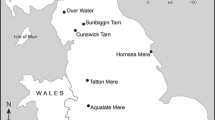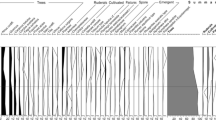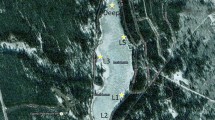Abstract
Recovery of the submersed vegetation is a target for the management of soft-water shallow lakes if they are to meet water quality and biodiversity standards. Knowledge of patterns of macrophyte space occupation and time to recovery is poor and mostly restricted to free floating species or riparian vegetation. Here we use pre- and post-impact monitoring data over 20 years showing the evolution of submersed aquatic vegetation of lake Baciver (Pyrenees), and develop models to infer space occupation and time to recovery. We use pre-impact macrophyte distribution in relation to bathymetry-derived data to fit logistic models to further simulate lake equilibrium scenarios. Depth and slope were found to be the best predictors, and models suggested that an assemblage dominated by Sparganium angustifolium was, at time of this study, over 95% of its potential distribution area. A dense, newly grown monospecific Isoetes lacustris population occupied <10% of its potential area and model projections suggest that it will take decades to recover. An I. lacustris residual population remains below the estimated depth threshold for survival and is bound to disappear. The lake appears to evolve towards a new steady-state where the current lake hypsography promotes the expansion of algae (Nitella sp.) over angiosperms.





Similar content being viewed by others
References
Arts, G. H. P., 2002. Deterioration of atlantic soft water macrophyte communities by acidification, eutrophication and alkalinisation. Aquatic Botany 73: 373–393.
Azzella, M. M., R. Bolpagni & A. Oggioni, 2014. A preliminary evaluation of lake morphometric traits influence on colonization depth of Aquatic plants. Journal of Limnology 73(2): 400–406.
Baastrup-Spohr, L., K. J. Sand-Jensen, S. V. Nicolajsen & H. H. Bruun, 2015. From soaking wet to bone dry: predicting plant community composition along a steep hydrological gradient. Journal of Vegetation Science 26(4): 610–630.
Ballesteros, E., E. Gacia & L. Camarero, 1989. Composition, distribution and biomass of benthic macrophyte communities from lake Baciver, a Spanish alpine lake in the central Pyrenees. Annales de Limnologie 25(2): 177–184.
Bellemakers, M. J. S., M. Maessen, G. M. Verheggen & J. G. M. Roelofs, 1996. Effects of liming on shallow acidified moorland pools: a culture and a seed bank experiment. Aquatic Botany 54(1): 1996.
Bivand, R. S., E. Pebesma & V. Gómez-Rubio, 2013. Applied Spatial Data Analysis with R, 2nd edn. UseR! Series. Springer, New York.
Brederveld, R. J., S. C. Jähnig, A. W. Lorenz, S. Brunzel & M. B. Soons, 2011. Dispersal as a limiting factor in the colonization of restored mountain streams by plants and macroinvertebrates. Journal of Applied Ecology 48: 1241–1250.
Brouwer, E. & J. G. M. Roelofs, 2001. Degraded soft-water lakes: possibilities for restoration. Restoration Ecology 9: 155–166.
Brun, F. G., F. Cummaudo, I. Olive, J. J. Vergara & J. L. Perez-Llorens, 2007. Clonal extent, apical dominance and networking features in the phalanx angiosperm Zostera noltii Hornem. Marine Biology 151(5): 1917–1927.
Catalán, J., E. Ballesteros, E. Gacia, A. Palau & L. Camarero, 1993. Chemical composition of disturbed and undisturbed high-mountain lakes in the Pyrenees: a reference for acidified sites. Water Research 27(1): 133–141.
Catalan, J., G. Barbieri, F. Bartumeus, P. Bitušík, P. Botev, A. Brancelj, D. Cogălniceanu, M. Manca, A. Marchetto, N. Ognjanova-Rumenova, S. Pla, M. Rieradevall, S. Sorvari, E. Štefková, E. Stuchlík & M. Ventura, 2009. Ecological thresholds in European alpine lakes. Freshwater Biology 54(12): 2494–2517.
Chappuis, E. M., A. Lumbreras, E. Ballesteros & E. Gacia, 2015. Deleterious interaction of light impairment and organic matter enrichment on Isoetes lacustris (Lycopodiophyta, Isoetales). Hydrobiologia 760(1): 145–158.
Cutler, D. R., T. C. Edwards, K. H. Beard, A. Cutler, K. T. Hess, J. Gibson & J. J. Lawler, 2007. Random forests for classification in ecology. Ecology 88(11): 2783–2792.
Dormann, C. F., 2007. Assessing the validity of autologistic regression. Ecological Modelling 207(2): 234–242.
Dormann, C. F., J. M. McPherson, M. B. Araújo, R. Bivand, J. Bolliger, G. Carl, R. G. Davies, A. Hirzel, W. Jetz, W. D. Kissling, I. Kühn, R. Ohlemüller, P. R. Peres-Neto, B. Reineking, B. Schröder, F. M. Schurr & R. Wilson, 2007. Methods to account for spatial autocorrelation in the analysis of species distributional data: a review. Ecography 30(5): 609–628.
Duarte, C. M. & J. Kalff, 1986. Littoral slope as a predictor of the maximum biomass of submerged macrophyte communities. Limnology and Oceanography 31(5): 1072–1080.
Farmer, A. M. & D. H. M. Spence, 1986. The growth strategies and distribution of isoetids in Scottish freshwater lochs. Aquatic Botany 26: 247–258.
Fawcett, T., 2006. An introduction to ROC analysis. Pattern Recognition Letters 27: 861–874.
Gacia, E., 1993. Ecologia dels macròfits submergits dels estanys del Pirineu: estructura i dinàmica de les poblacions de l’estany de Baciver (Vall d’Aran). PhD Thesis, Ecology Department of the University of Barcelona: 176 pp.
Gacia, E. & E. Ballesteros, 1993. Population and individual variability of Isoetes lacustris L. with depth in a Pyrenean Lake. Aquatic Botany 46: 35–47.
Gacia, E. & E. Ballesteros, 1994. Production of Isoetes lacustris in a Pyrenean lake: seasonality and ecological factors involved in the growing period. Aquatic Botany 48: 77–89.
Gacia, E. & E. Ballesteros, 1996. The effect of increased water level on Isoetes lacustris L. in Lake Baciver, Spain. Journal of Aquatic Plant Management 34: 57–59.
Gacia, E. & E. Ballesteros, 1998. Changes in the water column, the sediment and the macrophyte populations after the building up of a dam in Lake Baciver (Central Pyrennes). Oecologia Aquatica 11: 55–66.
Gacia, E., E. M. Chappuis, A. Lumbreras, J. L. Riera & E. Ballesteros, 2009. Functional diversity of macrophyte communities within and between Pyrenean Lakes. Journal of Limnology 68(1): 25–36.
Grace, J. B., 1993. The adaptative significance of clonal reproduction in angiosperms: an aquatic perspective. Aquatic Botany 44: 159–180.
GRASS Development Team, 2015. Geographic Resources Analysis Support System (GRASS) Software, Version 7.0. Open Source Geospatial Foundation. http://grass.osgeo.org.
Helsten, S., 2002. Aquatic macrophytes as indicators of water-level regulation in Northern Finland. Proceedings – International Association of Theoretical and Applied Limnology 28: 601–606.
Hickey, R. J., 1986. Isoetes megaspore surface morphology: nomenclature, variation and 468 systematic importance. American Fern Journal 76: 1–16.
Hijmans, J. R., 2014. Raster: Geographic Data Analysis and Modeling. R Package Version 2.3-0. http://CRAN.R-project.org/package=raster.
Howard, W. C., A. M. Schwarz & W. F. Vincent, 1995. Deep-water aquatic plant communities in an oligotrophic lake: physiological responses to variable light. Freshwater Biology 33(1): 91–102.
Khanna, S., M. J. Santos, E. L. Hestir & S. L. Ustin, 2012. Plant community dynamics relative to the changing distribution of a highly invasive species, Eichhornia crassipes: a remote sensing perspective. Biological Invasions 14: 717–733.
Kolada, A., 2014. The effect of lake morphology on aquatic vegetation development and changes under the influence of eutrophication. Ecological Indicators 38: 282–293.
Madsen, J. D., P. A. Chambers, W. F. James, E. W. Koch & D. F. Westlake, 2001. The interaction between water movement, sediment dynamics and submersed macrophytes. Hydrobiologia 444(1–3): 71–84.
Pollux, B. J. A., E. Verbruggen, J. J. Van Groenendael & N. J. Ouborg, 2006. Intraspecific variation of seed floating ability in Sparganium emersum suggests a bimodal dispersal strategy. Aquatic Botany 90: 199–203.
Portielje, R. & D. T. Van der Molen, 1998. Trend-analysis of eutrophication variables in lakes in The Netherlands. Water Science and Technology 37: 235–240.
Pulido, C., E. C. H. E. T. Lucassen, O. Pedersen & J. G. M. Roelofs, 2011a. Influence of quantity and lability of sediment organic matter on the biomass of two isoetids, Littorella uniflora and Echinodorus repens. Freshwater Biology 56: 939–951.
Pulido, C., D. J. H. Keijsers, E. C. H. E. T. Lucassen, O. Perdersen & J. G. M. Roelofs, 2011b. Elevated alkalinity and sulfate adversely affect the aquatic macrophyte Lobelia dortmanna. Aquatic Ecology 46: 283–295.
Pulido, C., J. L. Riera, E. Ballesteros, E. Chappuis & E. Gacia, 2015. Predicting aquatic macrophyte occurrence in soft-water oligotrophic lakes (Pyrenees mountain range). Journal of Limnology 74(1): 143–154.
QGIS Development Team, 2014. QGIS Geographic Information System. Open Source Geospatial Foundation Project. http://qgis.osgeo.org/.
R Core Team, 2014. R: A Language and Environment for Statistical Computing. R Foundation for Statistical Computing, Vienna. http://www.R-project.org/.
Riis, T., 2008. Dispersal and colonization of plants in lowland streams: success rates and bottlenecks. Hydrobiologia 596: 341–351.
Robin, X., N. Turck, A. Hainard, N. Tiberti, F. Lisacek, J.C. Sanchez & M. Müller, 2011. pROC: an open-source package for R and S+ to analyze and compare ROC curves. BMC Bioinformatics 12: 77.
Rørslett, B., 1984. Environmental factors and aquatic macrophyte response in regulated lakes – a statistical approach. Aquatic Botany 19: 199–220.
Rørslett, B., 1989. An integrated approach to hydropower impact assessment II. Submerged macrophytes in some Norwegian hydro-electric lakes. Hydrobiologia 175: 65–82.
Rørslett, B. & S. W. Johansen, 1996. Remedial measures connected with aquatic macrophytes in Norwegian regulated rivers and reservoirs. Regulated Rivers: Research & Management 12: 509–522.
Sand Jensen, K. J. & T. V. Madsen, 1992. Patch dynamics of the stream macrophyte, Callitriche cophocarpa. Freshwater Biology 27: 277–282.
Sand-Jensen, K., T. Riis, O. Vestergaard & S. E. Larsen, 2000. Macrophyte decline in Danish lakes and streams over the past 100 years. Journal of Ecology 88: 1030–1040.
Sintes, T., N. Marbà & C. M. Duarte, 2006. Modeling nonlinear seagrass clonal growth: assessing the efficiency of space occupation across the seagrass flora. Estuaries and Coasts 29(1): 72–80.
Vila-Costa, M., C. Pulido, E. M. Chappuis, A. Calviño, E. Casamayor & E. Gacia, 2016. Macrophyte landscape modulates lake ecosystem-level nitrogen losses through tightly coupled plant-microbe interactions. Limnology and Oceanography 61(1): 78–88.
Acknowledgements
E.G. and E.C. are members of the Environmental Changes Ecology Group (GECA), an Excellence Research Group (SGR-DGR) of the Generalitat de Catalunya (Ref. 2014 SGR 1249. 2014–2017). This study was funded by the Red de Parques Nacionales of the Spanish Ministry of the Environment (PN I+D+I ref. 118/2003 and AQUAREST ref. OAPN 212/2010) and Intramural CSIC (Consejo Superior de Investigaciones Científicas) ref. 0065. The authors are thankful to Lluís Camarero for help processing lake nutrient analysis and to Ana Lumbreras for field and lab assistance during the summer of 2005.
Author information
Authors and Affiliations
Corresponding author
Additional information
Handling editor: André Padial
Electronic supplementary material
Below is the link to the electronic supplementary material.
Rights and permissions
About this article
Cite this article
Riera, J.L., Ballesteros, E., Pulido, C. et al. Recovery of submersed vegetation in a high mountain oligotrophic soft-water lake over two decades after impoundment. Hydrobiologia 794, 139–151 (2017). https://doi.org/10.1007/s10750-017-3087-5
Received:
Revised:
Accepted:
Published:
Issue Date:
DOI: https://doi.org/10.1007/s10750-017-3087-5




